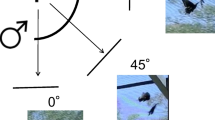Summary
-
1.
MaleEurema lisa butterflies have specialized scales on the dorsal wing surfaces which selectively and directionally reflect ultraviolet light via an interference phenomenon. Females lack such scales.
-
2.
When perched and approached by another butterfly, individuals of both sexes may open and close the wings several times in rapid succession. This behavior, previously observed in other pierids, has been called the “flutter response”.E. lisa males contact and attempt to copulate with females whether or not they perform the flutter response. Fluttering males are ignored.
-
3.
The flutter response has the spatial characteristics necessary to display the male's directional ultraviolet reflectance. Temporal differences between the flutter responses of males and females are small.
-
4.
A two-choice discrimination assay in which static butterflies were presented to caged males demonstrated thatE. lisa males can distinguish females from conspecific males solely on the basis of ultraviolet reflectance.
-
5.
Ventral wing coloration and presence or absence of a wing bar effects the attractiveness of a butterfly toE. lisa males. A scheme is suggested by which a maleE. lisa distinguishes conspecific females from males and females of two similar and sympatric species.
Similar content being viewed by others
References
Crane, J.: Imaginal behavior of a Trinidad Butterfly,Heliconius erato hydara Hewitson, with special reference to the social use of color. Zoologica (N.Y.)40, 167–196 (1955)
Eisner, T., Silberglied, R.E., Aneshansley, D., Carrel, J.E., Howland, H.C.: Ultraviolet video-viewing: the television camera as an insect eye. Science166, 1172–1174 (1969)
Ghiradella, H., Aneshansley, D., Eisner, T., Silberglied, R.E., Hinton, H.E.: Ultraviolet reflection of a male butterfly: interference color caused by thin layer elaboration of wing scales. Science178, 1214–1217 (1972)
Hamilton, W.J., III: Sun-oriented display of the Anna's hummingbird. Wilson Bull.77, 38–44 (1965)
Ilse, D.: Über den Farbensinn der Tagfalter. Z. vergl. Physiol.8, 658–692 (1928)
Lederer, G.: Verhaltensweisen der Imagines und der Entwicklungsstadien vonLimenitis camilla camilla L. (Lep., Nymphalidae). Z. Tierpsychol.17, 521–546 (1960)
Magnus, D.B.E.: Experimental analysis of some “over-optimal” sign stimuli in the mating behavior of the fritillary butterflyArgynnis paphia L. (Lep., Nymphalidae). Proc. Xth Intern. Congr. Entomol. (Montreal)2, 405–418 (1958)
Makino, K., Satoh, K., Koike, M., Ueno, N.: Sex inPieris rapae L. and the pteridin content of their wings. Nature (Lond.)170, 933–934 (1952)
Obara, Y.: Mating behavior of the cabbage white,Pieris rapae crucivora. II. The “mate-refusal posture” of the female. Zool. Mag.73, 175–178 (1964)
Obara, Y.: Studies on the mating behavior of the white cabbage butterfly,Pieris rapae crucivora Boisduval. III. Near-ultraviolet reflection as the signal of intraspecific communication. Z. vergl. Physiol.69, 99–116 (1970)
Obara, Y., Hidaka, T.: Mating behavior of the cabbage white,Pieris rapae crucivora. I. The “flutter response” of the resting male to flying males. Zool. Mag.73, 131–135 (1964)
Silberglied, R.E.: Ultraviolet reflection of pierid butterflies: Phylogenetic implications and biological significance. Master's Thesis. Cornell University (1969)
Silberglied, R.E.: Ultraviolet reflection and its behavioral role in the genusColias (Lepidoptera Pieridae). Doctoral Dissertation. Harvard University (1973)
Scott, J.A.: Mating of butterflies. J. Res. Lep.11, 99–127 (1973)
Stride, G.O.: Investigations into the courtship behavior of the male ofHypolimnas misippus L. (Lepidoptera, Nymphalidae), with special reference to the role of visual stimuli. Anim. Behav.5, 153–167 (1957)
Tinbergen, N., Meeuse, B.J.D., Boerma, L.K., Varossieau, W.W.: Die Balz des Samtfalters,Eumenis (Satyrus) semele (L.). Z. Tierpsychol.5, 182–226 (1942)
Author information
Authors and Affiliations
Additional information
Many thanks are due: to Dr. Thomas Eisner for his support, advise and encouragement throughout the work; to Mr. Richard Archbold who established and supports the excellent facilities and staff found at the Archbold Biological Station in Lake Placid, Florida, where most of this work was done; to Dr. Jeffrey Camhi for the use of his Vanguard Motion Analyzer; to Drs. John Alcock, W.L. Brown, R.R. Capranica, D. Tapper, and Mr. W. Linn Montgomery for their critical reading of the manuscript. Financial support for this work came from a Sigma Xi Grant-in-Aid-of-Research, a Bache Fund Award, NSF Grant No. BMS-74-15084 (to T. Eisner), and NIH Grant No. AI-02908.
Rights and permissions
About this article
Cite this article
Rutowski, R.L. The use of visual cues in sexual and species discrimination by males of the small sulphur butterflyEurema lisa (lepidoptera, pieridae). J. Comp. Physiol. 115, 61–74 (1977). https://doi.org/10.1007/BF00667785
Received:
Issue Date:
DOI: https://doi.org/10.1007/BF00667785




